Cite this document
(“Critical Analysis of Diamond Shipwreck and Tang Shipwreck as the Essay”, n.d.)
Critical Analysis of Diamond Shipwreck and Tang Shipwreck as the Essay. Retrieved from https://studentshare.org/history/1458826-critical-analysis-of-diamond-shipwreck-and-tang-shipwreck-as-the-milestones-in-the-world-trade-relationship
Critical Analysis of Diamond Shipwreck and Tang Shipwreck as the Essay. Retrieved from https://studentshare.org/history/1458826-critical-analysis-of-diamond-shipwreck-and-tang-shipwreck-as-the-milestones-in-the-world-trade-relationship
(Critical Analysis of Diamond Shipwreck and Tang Shipwreck As the Essay)
Critical Analysis of Diamond Shipwreck and Tang Shipwreck As the Essay. https://studentshare.org/history/1458826-critical-analysis-of-diamond-shipwreck-and-tang-shipwreck-as-the-milestones-in-the-world-trade-relationship.
Critical Analysis of Diamond Shipwreck and Tang Shipwreck As the Essay. https://studentshare.org/history/1458826-critical-analysis-of-diamond-shipwreck-and-tang-shipwreck-as-the-milestones-in-the-world-trade-relationship.
“Critical Analysis of Diamond Shipwreck and Tang Shipwreck As the Essay”, n.d. https://studentshare.org/history/1458826-critical-analysis-of-diamond-shipwreck-and-tang-shipwreck-as-the-milestones-in-the-world-trade-relationship.


